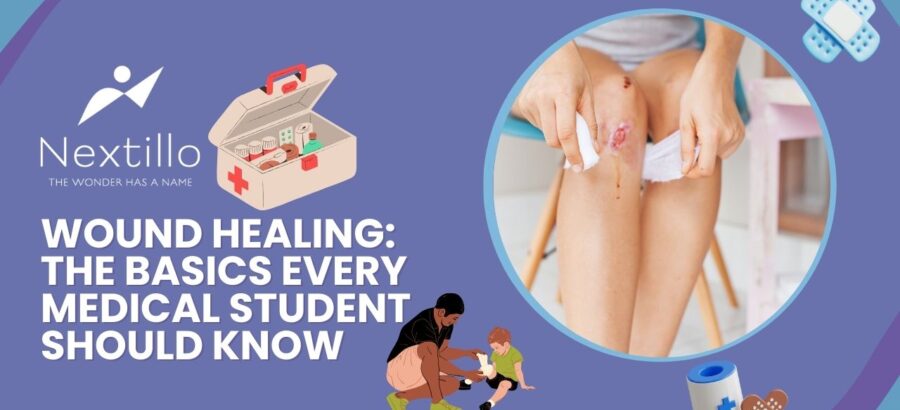Wound healing is a complex and dynamic process that involves multiple stages. It is one of the most fundamental processes of the human body, and medical students and clinicians need to understand it. In this blog, we’ll further break down the basics of wound healing, which include the four major phases.
Wound healing is divided into four stages: hemostasis, inflammation, proliferation, and remodeling. Each phase has a specific function in healing the damaged tissue.
Hemostasis
Hemostasis is the first response to injury and involves an immediate step of the body to stop bleeding. This phase begins within seconds of injury and includes vascular constriction, platelet aggregation, and activation of the coagulation cascade.
- Vasoconstriction: After an injury, blood vessels constrict to decrease blood flow to the wound.
- Platelet Aggregation: Platelets adhere to exposed subendothelial collagen and to other platelets and forms a temporary platelet plug.
- Coagulation Cascade: This is initiated by the injury by a series of consecutive enzymatic reactions that forms the fibrin which helps in stabilizing the plug and form a clot.
Together, all these three actions stop the bleeding.
Inflammation
This stage occurs a few days after hemostasis. It is an important stage that will help in clearing the debris, prevention of infection and setting up of a wound bed ready for the production of new tissue.
- Dilation: Blood vessels dilate, and this causes the increase in blood supply to the site of injury. Dilation provides the transfer of nutrients, immune cells, and oxygen to the site of injury.
- Immune Cell Recruitment: White blood cells, including neutrophils and macrophages migrate to the to the site of injury. Neutrophils primarily clears the wound by phagocytosing bacteria and debris. Macrophages are crucial in clearing the wound and by signaling to start tissue repair.
- Cytokine and Growth Factor Release: Macrophages and other cells release signaling molecules such as cytokines and growth factors (e.g., VEGF, TGF-β) that coordinate the healing process.
Although inflammation is crucial, overexpression or over-time inflammation can prevent healing and give rise to chronic wounds.
Proliferation
The proliferative phase begins after day 3 post-injury and can continue for weeks. During this period, the wound is filled up with new tissue with the help of processes like epithelialization, angiogenesis, and fibroplasia.
Angiogenesis: New blood vessels are formed to provide the tissue the required elements for their metabolism.
Fibroplasia: At this stage, fibroblasts play an important role. They move into the wound and produce extracellular matrix components like collagen that provides structural support to the wound bed.
Epithelialization: This is a step where keratinocytes will continue to move through the wound bed to seal over the wound, thereby reconstituting the normal skin surface layer.
Wound Contraction: Myofibroblasts are specialized and differentiated fibroblasts, and these will pull or contract the wound to shrink and close the edges.
Remodeling (Maturation)
The remodeling phase of the wound healing is the last stage, and it lasts for months to years.
It is the stage in which the collagen matrix is reorganized and strengthened with continuous contraction of the wound. The scar tissue that is formed during the healing process gets stronger and more organized but never gets the strength of the original tissue.
- Collagen Remodeling: In this phase of collagen remodelling the type III collagen which is laid down by fibroblasts and it is replaced gradually by the stronger Type I collagen.
- Scar Maturation: In this phase of remodeling, the scar tissue becomes more flatter, less vascular, and more flexible with time. Although the scar tissue is functional, it lacks the strength and elasticity of the original tissue, hence it is more vulnerable to injury.
Factors Affecting Wound Healing
There are several intrinsic and extrinsic factors that affect wound healing. These factors are playing a very important role in wound healing, and thus they can’t be ignored.
Read more: Surgery Blogs for Fmge and Neet PG Preparation
Intrinsic Factors:
- Age: Older people and adults heal wounds slowly because of decreased cellular function and slower collagen synthesis as compared to young people and children.
- Comorbidities: Conditions such as diabetes, vascular diseases, and immune compromised people have slower wound healing. In diabetes the elevated levels of blood sugar is the main cause of delayed wound healing as this damages the immune functions and decreases collagen synthesis.
- Nutrition: Good nutrition is needed for healing a wound. Any deficiencies in vitamins and minerals, including vitamin C, zinc, and protein, will decrease the rate of healing.
- Hormones: Alterations in the hormones, e.g., during pregnancy or from the use of corticosteroids, affect the healing of the wound.
- Medications: patients on chemotherapy and immunosuppressive drugs alter the healing of wounds.
Extrinsic Factors:
Infection: This is one of the most frequent complications leading to the delay in healing of the wound
Mechanical Stress: Wound healing is affected by increased movement or pressure at the wound site, leading to dehiscence of the wound or scarring.
Smoking: Smoking affects circulation; thus, oxygen delivery to the wound site is decreased, and this consequently delays healing.
Complications of wound healing
- Deficient scar formation leads to rupture of wounds and ulcer formation.
- Excessive production of repair tissues, which leads to conditions like keloid formation.






